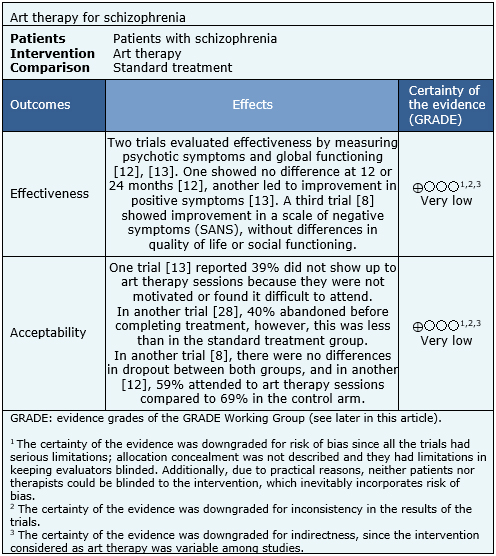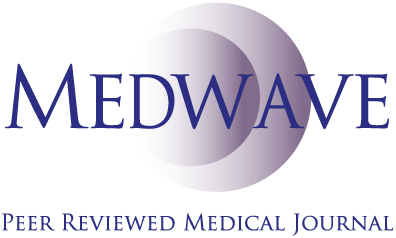Epistemonikos summaries
← vista completaPublished on January 19, 2017 | http://doi.org/10.5867/medwave.2017.6845
Art therapy for schizophrenia?
Arteterapia, ¿es efectiva en la esquizofrenia?
Abstract
Art therapy is used as a complementary treatment to antipsychotics in schizophrenia. However, its effectiveness is not clear. To answer this question, we searched in Epistemonikos database, which is maintained by screening multiple databases. We identified five systematic reviews including 20 studies overall, of which four were randomized trials. We extracted data and prepared summary of findings tables using the GRADE method. We concluded it is not clear whether art therapy leads to clinical improvement in schizophrenia because the certainty of the evidence is very low.
Problem
Many patients with schizophrenia remain symptomatic despite pharmacotherapy. For this reason, other types of interventions are recommended, such as those focused on art or art therapy. The British Association of Art Therapists defines this treatment as “a form of psychotherapy that uses art media as its primary mode of expression and communication” [1], in which art is used as a medium to address emotional issues that cause distress.
It is thought this intervention would allow patients with schizophrenia to process emotional, cognitive and psychotic experiences through art. However, it is not clear whether it leads to a clinical improvement.
Methods
We used Epistemonikos database, which is maintained by screening multiple databases, to identify systematic reviews and their included primary studies. With this information, we generated a structured summary using a pre-established format, which includes key messages, a summary of the body of evidence (presented as an evidence matrix in Epistemonikos), meta-analysis of the total of studies, a summary of findings table following the GRADE approach and a table of other considerations for decision-making.
|
Key messages
|
About the body of evidence for this question
|
What is the evidence. |
We found five systematic reviews [2],[3],[4],[5],[6] that include 20 primary studies that answered the question of this summary (reported in 24 references) [7],[8],[9],[10], [11],[12],[13],[14],[15],[16],[17],[18],[19],[20],[21], [22],[23],[24],[25],[26],[27],[28],[29],[30], of which four are randomized controlled trials, reported in eight references [8],[12],[13],[14],[16],[17],[19],[28]. This table and the summary in general are based on the latter. Although the definition of art therapy can include interventions based on music, dance or other performing arts, we selected the definition used by most systematic reviews, that is, therapy centered in visual or plastic arts. |
|
What types of patients were included |
All of the trials included patients with schizophrenia. One trial included a group of patients with schizophrenia, depression, bipolar disorder and personality disorder [28]. Three trials intervened in an outpatient setting [8],[13], [28] and one with patients in closed hospitalization [12]. |
|
What types of interventions were included |
The intervention in three trials was designed according to the recommendations of the British Association of Art Therapists [8],[13],[28]. One trial [12] used psychodynamic art therapy; in spite of not explicitly adhering to the definition of the British Association, the description provided suggests it follows its recommendations. All interventions were provided in a group format. The frequency of sessions was variable. One trial delivered the intervention twice weekly [12], two trials weekly [8], [13] and one trial every other week [28]. The length of the intervention varied between six weeks and one year. All of the trials compared against standard treatment. One trial [13] also compared against a different group activity. |
|
What types of outcomes |
The trials measured multiple outcomes; however, the different systematic reviews grouped them as follows: effectiveness (Scale for the Assessment of Negative Symptoms [SANS], Brief Psychiatric Rating Scale [BPRS], Brief Symptom Inventory [BSI], scales of social functioning and quality of life) and acceptability. |
Summary of findings
The information about the effects of art therapy in schizophrenia is based on four randomized trials including 612 patients. Three trials reported effectiveness [8],[12],[13] and all trials included at least one measure of acceptability. The summary of findings is the following.
- It is not clear whether art therapy leads to clinical improvement in schizophrenia because the certainty of the evidence is very low.
- It is not clear whether art therapy is an intervention acceptable for patients because the certainty of the evidence is very low.


Other considerations for decision-making
|
To whom this evidence does and does not apply |
|
| About the outcomes included in this summary |
|
| Balance between benefits and risks, and certainty of the evidence |
|
| What would patients and their doctors think about this intervention |
|
| Resource considerations |
|
|
Differences between this summary and other sources |
|
| Could this evidence change in the future? |
|
How we conducted this summary
Using automated and collaborative means, we compiled all the relevant evidence for the question of interest and we present it as a matrix of evidence.

Follow the link to access the interactive version: Art therapy for schizophrenia and schizophrenia-like disease
Notes
The upper portion of the matrix of evidence will display a warning of “new evidence” if new systematic reviews are published after the publication of this summary. Even though the project considers the periodical update of these summaries, users are invited to comment in Medwave or to contact the authors through email if they find new evidence and the summary should be updated earlier. After creating an account in Epistemonikos, users will be able to save the matrixes and to receive automated notifications any time new evidence potentially relevant for the question appears.
The details about the methods used to produce these summaries are described here http://dx.doi.org/10.5867/medwave.2014.06.5997.
Epistemonikos foundation is a non-for-profit organization aiming to bring information closer to health decision-makers with technology. Its main development is Epistemonikos database (www.epistemonikos.org).
These summaries follow a rigorous process of internal peer review.
Conflicts of interest
The authors do not have relevant interests to declare.

